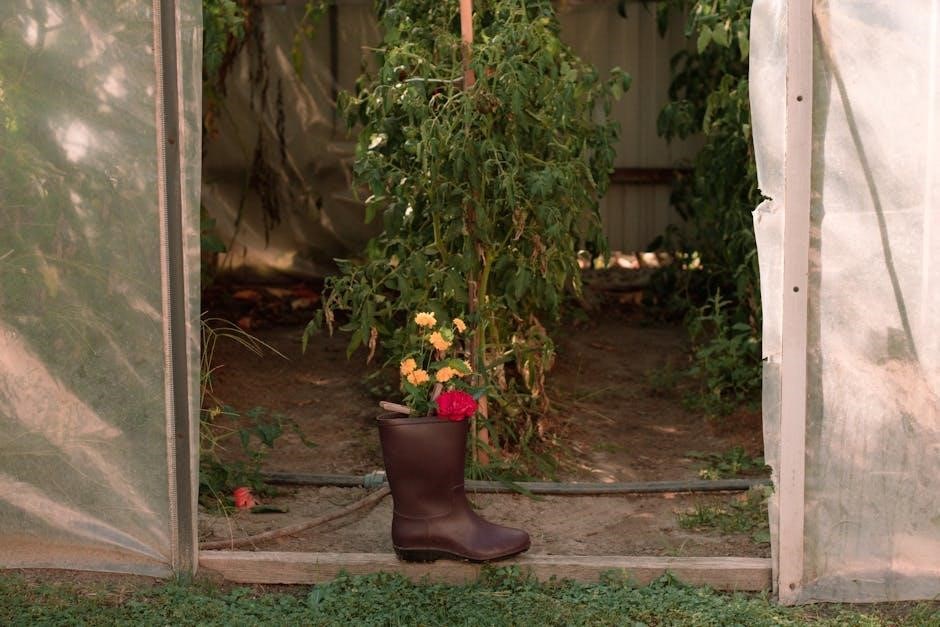The short story “The Flowers” by Alice Walker is a poignant tale from her collection In Love and Trouble (1973), exploring themes of innocence and racial tension. Available as a PDF, it remains a significant work in Walker’s oeuvre, offering a powerful narrative of a young girl’s transformative experience.
Background of the Story
“The Flowers” by Alice Walker is a short story from her collection In Love and Trouble: Stories of Black Women, published in 1973. The narrative centers around Myop, a young Black girl who discovers a decomposed body while picking flowers in a field. This harrowing experience abruptly ends her childhood innocence, exposing her to the harsh realities of racial violence and injustice. Set in the rural South, the story explores themes of racial tension, loss of innocence, and the brutal consequences of systemic racism. The story’s vivid imagery and emotional depth have made it a significant work in Walker’s oeuvre, resonating with readers for its unflinching portrayal of a tragic event. The PDF version of the story is widely available for educational and personal reading.
Publication and Availability (including PDF)

“The Flowers” by Alice Walker was first published in her collection In Love and Trouble: Stories of Black Women in 1973 by Harcourt Brace Jovanovich. The story is available in various formats, including PDF, for easy access and reading. The PDF version can be downloaded from platforms like ResearchGate, SparkNotes, and other academic websites. It is also available as a free text file or for online reading. The story is widely studied in literature classes, and its digital formats make it accessible to students and readers worldwide. The PDF version retains the original formatting and content, ensuring an authentic reading experience. Additionally, the story is often included in anthologies and study materials, further enhancing its accessibility for educational purposes.

Major Themes in “The Flowers”
The story explores themes of loss of innocence and racial tension, as a young girl’s encounter with a decomposed body shatters her childhood innocence and reveals harsh realities.
Loss of Innocence
The theme of loss of innocence is central to Alice Walker’s “The Flowers,” as the protagonist, Myop, experiences a profound shift in her perception of the world; Initially, Myop is portrayed as a carefree child, joyfully picking flowers in a lush field. However, her discovery of a decomposed, decapitated body shatters her naivety, exposing her to the harsh realities of life and death. This moment marks a turning point, as Myop’s innocence is irreparably lost, replaced by a somber understanding of the world’s cruelties. The story underscores how such experiences abruptly end childhood and force individuals to confront the complexities of adulthood. The imagery of Myop laying down her flowers symbolizes the end of her innocent summer and her transition into a more mature, yet sorrowful, awareness of life.
Racial Tension
Racial tension is a significant undercurrent in Alice Walker’s “The Flowers,” reflecting the deep-seated racial conflicts prevalent in the rural South during the era depicted. The discovery of the decomposed body, later revealed to be that of a Black man, underscores the violent legacy of racial discrimination and lynching. This incident serves as a stark reminder of the systemic oppression faced by African Americans, highlighting societal attitudes that dehumanized and marginalized them. The body’s state of decay symbolizes the broader disregard for Black lives, emphasizing the racial divide and injustice embedded within the community. Through this narrative, Walker critiques the racial violence and inequality that permeated American society, using the body as a poignant representation of the tragic consequences of racial hatred and the enduring scars it leaves.
Character Analysis
Character Analysis in “The Flowers” focuses on Myop, a young girl whose innocence and curiosity drive the narrative. The decomposed body symbolizes the harsh realities of racial violence, contrasting with Myop’s naivety and highlighting the loss of innocence.
Myop’s Character
Myop, the young protagonist of “The Flowers,” is portrayed as a curious and innocent child. Her name, meaning “myopia” or nearsightedness, symbolizes her limited perspective on the world. Initially, she is engrossed in the beauty of nature, collecting flowers and exploring the surroundings of her sharecropper family’s land. Her innocence is evident in her fascination with the natural world, which serves as an escape from the harsh realities of her environment. However, her discovery of the decomposed body in the field marks a turning point, forcing her to confront the brutal truths of racial violence and injustice. Through Myop’s character, Alice Walker highlights the fragility of childhood innocence and the abrupt awakening to the cruelties of the adult world.
The Role of the Decomposed Body
The decomposed body in “The Flowers” serves as a powerful and haunting symbol, marking a pivotal moment in the story. It represents the harsh realities of racial violence and injustice in the rural South during the era of segregation. The body, likely a victim of lynching, signifies the brutal consequences of racial hatred and the long-standing wounds of the community. Myop’s discovery of the body shatters her innocence, forcing her to confront the darker aspects of her world. The body also acts as a silent witness to history, reminding readers of the violent legacy of racism. Its presence underscores the story’s themes of loss, injustice, and the enduring impact of racial tension on individuals and society.

Symbolism in the Story
The flowers symbolize innocence and its loss, while the field represents a place of transition and discovery. The decomposed body signifies racial violence and its haunting legacy.
Flowers as Symbols
In “The Flowers,” the flowers symbolize innocence, purity, and the fleeting nature of childhood. Myop gathers them innocently, unaware of the horrors she will discover. The flowers represent her untainted perspective and joy, contrasting sharply with the grim reality of racial violence. Their beauty and vibrancy highlight the stark juxtaposition between Myop’s innocence and the brutal decomposition of the body she finds. The flowers also serve as a metaphor for the loss of purity, as Myop’s encounter with death and racism shatters her naive worldview. This symbolism underscores the tragedy of innocence lost to the harsh realities of a racially divided world.
The Field’s Significance
The field in “The Flowers” holds profound symbolic meaning, representing both innocence and the harsh realities of racial violence. It is a place where Myop gathers flowers, symbolizing her connection to nature and childhood. However, the field also serves as the site of a horrific discovery, revealing the decomposed body of a lynched man. This duality underscores the contrast between the beauty of nature and the ugliness of human brutality. The field acts as a silent witness to historical atrocities, symbolizing the hidden truths of racial oppression. Its isolation and vastness emphasize the secrecy surrounding such crimes, while also highlighting the inevitability of their revelation. The field, thus, becomes a powerful symbol of transformation and racial history.

Plot Summary
Myop, a young girl, wanders through a field, collecting flowers, unaware of the horrors of racial violence; Her innocence shatters upon discovering a decomposed body.
Structure and Pacing
The story unfolds with a serene tone, introducing Myop’s carefree exploration of the field. Walker’s structure builds tension subtly, shifting from innocence to horror. The pacing accelerates as Myop discovers the decomposed body, contrasting sharply with the initial peaceful atmosphere. The narrative’s brevity and directness heighten the emotional impact, leaving readers with a haunting reflection on racial violence. Walker’s concise prose avoids unnecessary details, focusing on the pivotal moment that shatters Myop’s innocence. This structure emphasizes the tragedy’s abruptness, mirroring the harsh realities of racial oppression. The pacing ensures a powerful, unforgettable conclusion that lingers in the reader’s mind.

Climax and Ending
The climax of The Flowers occurs when Myop discovers the decomposed body, a moment that shatters her innocence. Walker masterfully crafts this scene to evoke horror and reflection, forcing Myop—and the reader—to confront the harsh realities of racial violence. The ending leaves a lingering sense of tragedy, as Myop gathers flowers for the dead man, symbolizing a grim awakening to the world’s cruelty. The story concludes abruptly, emphasizing the finality of death and the irreversible loss of innocence. This ending underscores Walker’s intent to highlight the brutal truths of racial oppression, leaving a profound and haunting impression on the reader. The simplicity of the ending amplifies its emotional weight, ensuring the story’s message resonates deeply.
Historical Context
Set in the rural South during a period of racial tension, Alice Walker’s The Flowers reflects the harsh realities of African American life in early 20th-century America.
Setting in the Rural South

The story is set in the rural South, a region marked by vast fields and a quiet, isolating landscape. This setting reflects the era of racial segregation and tension, where African Americans faced systemic oppression. The rural South during this time was characterized by its vast, open spaces and the quiet, unassuming life of its inhabitants. The fields and natural surroundings in the story symbolize both beauty and the harsh realities of life. The setting also highlights the economic struggles of sharecropping and the limited opportunities available to African Americans. This backdrop of rural life underscores the themes of innocence, racial conflict, and the tragic events that unfold. The isolation of the setting amplifies the story’s emotional impact, creating a sense of calm before the storm.
Impact of Race Relations

Race relations play a pivotal role in shaping the narrative of “The Flowers,” reflecting the deep-seated racial tensions of the era. The story highlights the harsh realities of racial conflict in the rural South, where African Americans faced systemic oppression and violence. The discovery of the decomposed body serves as a stark reminder of the brutal consequences of racial hatred and lynching. Myop’s innocence is shattered by this encounter, symbolizing the loss of childhood and the harsh awakening to racial realities. The story underscores the emotional and psychological toll of living in a society fraught with racial division. Through this, Alice Walker critiques the societal norms that perpetuated violence and inequality, offering a powerful commentary on the enduring impact of race relations.

Style and Structure
Alice Walker’s “The Flowers” employs a concise, direct narrative style, with simple yet evocative language. The story’s structure builds tension gradually, contrasting Myop’s innocent exploration with the horrifying discovery, emphasizing the emotional impact through its economy of words and vivid imagery.
Narrative Technique
Alice Walker employs a third-person narrative voice in “The Flowers,” creating a detached yet intimate perspective that mirrors Myop’s innocent worldview. The story’s narrative technique relies heavily on juxtaposition, contrasting the vibrant, idyllic imagery of nature with the grim discovery of the decomposed body. Walker’s use of understatement and subtle foreshadowing builds tension gradually, allowing the reader to experience Myop’s shift from naivety to awareness. The narrative’s brevity and simplicity underscore the profound impact of the events, while the focus on sensory details enhances the emotional weight of the story. This technique effectively conveys the loss of innocence and the harsh realities of racial violence, making the narrative both haunting and thought-provoking.

Language and Imagery
Alice Walker’s “The Flowers” features vivid and evocative language that immerses readers in Myop’s world. The story’s imagery is rich and symbolic, with descriptions of nature—like the “big yellow petals” and “stems covered with down”—contrasting sharply with the disturbing discovery of the decomposed body. Walker’s prose is concise yet powerful, using sensory details to convey both the beauty of the field and the horror of the moment. The juxtaposition of innocence and violence is heightened by the imagery, creating a haunting and unforgettable atmosphere. The language, though simple, carries deep emotional weight, emphasizing the fragility of childhood and the harsh realities of the world.
Reception and Resources
Critical acclaim surrounds “The Flowers” for its poignant themes. Widely studied in schools, it’s accessible via PDF, enhancing its educational reach.
Critical Response
Scholars and readers alike have praised The Flowers for its profound exploration of innocence, race, and mortality. Critics highlight its emotional depth and symbolic richness, with many noting its ability to evoke powerful reflections on human experience. The story’s concise yet impactful narrative has made it a staple in literary anthologies and educational curricula. Educators often recommend the PDF version for easy access, enabling students to analyze the text closely. The story’s cultural and historical significance continues to resonate, particularly in discussions about race and identity. Its enduring relevance ensures its place in both academic and casual reading lists, with the PDF format facilitating wider accessibility for global audiences.
Study Materials and PDFs
For in-depth analysis, various study materials and PDFs of The Flowers are available online. These resources include detailed study guides, essay examples, and literary analyses. PDF versions of the story, such as the Alice Walker The Flowers PDF, are widely accessible, making it easy for students and readers to access the text. Many educational websites offer downloadable PDFs with annotations and critical commentary, aiding in close reading and interpretation. Additionally, study aids like character maps, theme explanations, and historical context are provided to enhance understanding. These materials are invaluable for students and educators, offering a comprehensive approach to studying the story’s complexities and significance.
